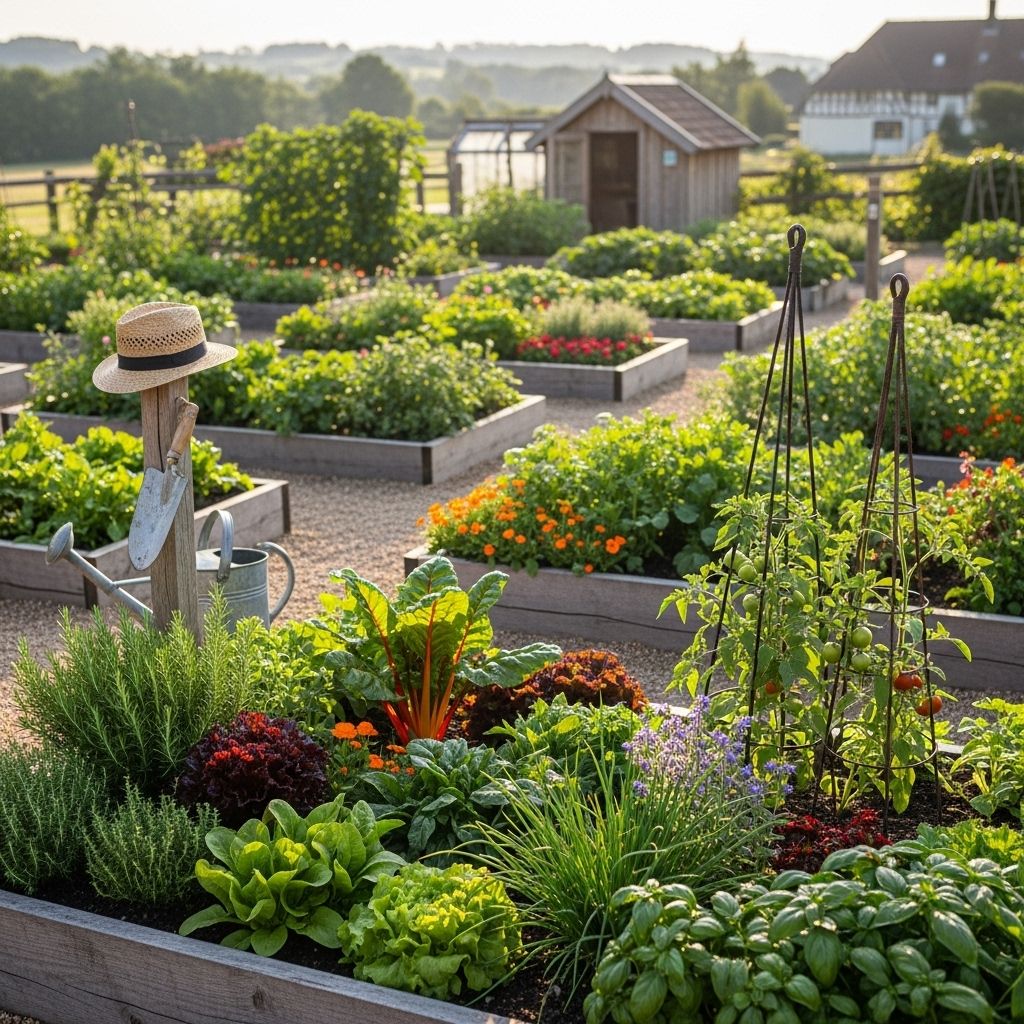Potager Guide: Expert Tips For A Productive Kitchen Garden
Ornamental layouts with edible plantings bring beauty and harvest together every season.

Garden Decoder: The Art and Essence of the Potager
Potager—the French kitchen garden—blends beauty, order, and productivity in a way that captures the imagination of gardeners and culinary enthusiasts alike. Far more than a mere patch of herbs or vegetables, the potager is an intentional landscape—a tapestry that delights the senses and nourishes the household. In this article, we decode the meaning, origins, key elements, and contemporary appeal of the potager, offering inspiration for transforming your edible garden into a living work of art.
What Is a Potager?
At its core, a potager is an ornamental kitchen garden designed to be visually pleasing while yielding a steady supply of herbs, fruits, vegetables, and edible flowers. Unlike traditional utility-based vegetable plots, a potager is meticulously laid out with symmetrical beds, defined pathways, and intentional plant pairings. It balances utility with aesthetics, blurring the line between food production and garden design. Patterns and repetition are utilized to provide year-round structure and interest, ensuring that the garden looks as good as it tastes.
The Historical Roots of the Potager
The word “potager” comes from the French potage, meaning soup or stew—dishes historically reliant on homegrown herbs and vegetables. Potagers emerged during the Middle Ages, evolving in monastic and manor gardens across France, where monks and householders mingled culinary plants with ornamentals for both sustenance and visual delight. Potagers are deeply woven into the fabric of French garden tradition, influencing kitchen garden designs worldwide.
- Medieval Origins: Early potagers were utilitarian, but structure and beauty were soon emphasized.
- Renaissance and Beyond: Aristocrats and enthusiasts adapted the potager style, inspiring grand designs such as those at Château de Villandry.
- Modern Influence: The potager ethos lives on in both grand estates and everyday backyard plots across the world.
Main Characteristics of a Potager
- Ornamental Layout: Patterns, symmetry, and repetitive motifs unite practicality and beauty.
- Mixed Plantings: Edibles are grouped with flowers and herbs for continuous color and harvest.
- Defined Boundaries: Low hedges, wattle, or brick paths outline beds and create striking visual compartments.
- Focal Points: Obelisks, arches, and statues provide structure and draw the eye.
- Continuous Productivity: Succession sowing and intercropping provide year-round yields and greenery.
Design Principles: Building a Beautiful and Productive Space
Creating a potager means thinking like both a designer and a gardener. Its layout is neither haphazard nor constrained to straight rows. Instead, form, color, texture, and rhythm are meticulously considered.
- Symmetry and Repetition: Beds are often laid out in mirrored or geometric patterns, anchoring the garden visually.
- Lines and Curves: Pathways, edgings, and the shapes of the beds define movement and guide the eye to featured elements.
- Focal Points: Every potager benefits from a centerpiece, such as a decorative urn, a berry bush, or an archway supporting climbing beans.
- Texture and Height: Mixing leafy greens, feathery herbs, upright vegetables, and trailing edible flowers brings dynamism and depth.
- Color Play: Integrate plants with diverse foliage and flower colors to maintain constant interest—from the deep purple of cabbages to the golden blossoms of calendula.
Layout Table: Essential Elements of a Potager
| Element | Function | Visual Impact |
|---|---|---|
| Symmetrical Beds | Efficient planting, structure | Order, balance |
| Central Focal Point | Draws attention, anchors design | Drama, emphasis |
| Pathways | Access, divides beds | Movement, definition |
| Mixed Plantings | Harvest variety, color | Seasonal richness |
| Ornamental Edges | Frames beds, hides gaps | Polished appearance |
Edible Elegance: What Grows in a Potager?
Potagers burst with variety, thanks to their integrated approach. The selection and arrangement of crops encourages both abundance and spectacle.
- Vegetables: Classic crops include lettuces, carrots, cabbages, leeks, and radishes.
- Herbs: Parsley, chervil, basil, rosemary, thyme, and tarragon are potager staples.
- Flowers: Marigold, calendula, nasturtium, and edible violets add color and attract pollinators.
- Soft Fruits: Strawberries, raspberries, currants, and gooseberries often line the edges or share space in beds.
Companion planting—pairing crops that benefit one another—is another hallmark, increasing yields and deterring pests naturally.
Year-Round Beauty and Function
Unlike patchwork annual vegetable plots, a well-designed potager remains attractive in every season. By combining perennials with fast-growing annuals, the garden avoids periods of emptiness. After heavy harvesting, gaps are quickly filled with “fast fillers” like chervil, cut-and-come-again greens, or late-season flowers to maintain lushness. Repetition, evergreen anchors, and constant replanting sustain both structure and productivity year-round.
Potager vs. Traditional Kitchen Garden
| Feature | Potager | Traditional Kitchen Garden |
|---|---|---|
| Design | Ornamental, geometric, mixed plantings | Functional, straight rows, separation of crops |
| Plant Mix | Vegetables, herbs, flowers, fruits mingled | Mainly vegetables, some herbs, little ornamentation |
| Visual Appeal | Year-round structure, continuous aesthetics | Practical, may appear bare after harvest |
| Maintenance | Requires continual replanting for visual/edible interest | Follows seasonal planting/harvesting schedule |
Planning Your Own Potager: Key Considerations
1. Location and Light
Choose the sunniest spot possible—potagers thrive with at least six hours of sunlight daily. Consider proximity to the kitchen for practical harvesting, or select a spot that balances visibility and function within your landscape.
2. Size and Scale
Potagers can be grand or compact. Scale the design to suit your needs, space, and maintenance ability. Even a modest collection of raised beds can capture the spirit of a potager if thoughtfully laid out.
3. Paths and Edges
Well-defined paths improve access and frame planting areas. Materials range from brick and gravel to mown grass, fit to the garden’s style and budget.
4. Ornamentation
Use trellises, obelisks, or topiary to guide the eye and support climbing crops. Decorative urns, birdbaths, or small statues make ideal centerpieces.
5. Rotation and Companion Planting
Plan crop rotation and utilize companion planting to encourage healthy plant growth, repel pests naturally, and ensure successive harvests.
Maintaining Beauty and Productivity Year-Round
- Edge Beds with Contrast: Grow low annuals or herbs to cover bare soil as vegetables are harvested.
- Fill Gaps Quickly: Sow fast-growing greens or annuals in empty patches to maintain fullness.
- Control Aggressive Species: Confine spreading herbs like mint to containers or define boundaries with underground barriers.
- Prune and Tidy: Regularly deadhead flowers and trim perennials to keep the garden in peak condition.
- Season Extension: Use cold frames and cloches to extend the harvest and garden interest into late autumn and early winter.
Real-Life Inspiration: The Hidden Potager
For those seeking a model, consider the hidden potager garden of horticulturist Catherine Horwood. Tucked behind mature hedges and brimming with symmetry, her plot features raised timber beds for vegetables and cut flowers, vertical accents like rusted obelisks for sweet peas, and a central archway reinforcing the sense of structure. The garden not only yields abundant produce and cut flowers but also forms a secluded retreat—showing that a potager’s beauty can be both functional and delightfully private.
Potager FAQs
Q: What does ‘potager’ mean?
A ‘potager’ is a French term for an ornamental kitchen garden that integrates vegetables, herbs, edible flowers, and decorative plants in visually harmonious beds.
Q: How is a potager different from a regular vegetable garden?
While a traditional vegetable garden focuses on practicality and yield, with straight rows of crops, a potager is designed for visual beauty, using patterned beds, mixed planting, and ornamental features year-round.
Q: What are the best plants to grow in a potager?
Choose a mix of leafy greens, root vegetables, culinary and medicinal herbs, edible flowers, and small fruits for both utility and aesthetic interest. Companion planting can enhance success.
Q: Do potagers require more maintenance?
Potagers require ongoing attention to replanting and tidiness to maintain both productivity and ornamental appeal, but the reward is a unique blend of abundance and beauty throughout the year.
Q: Can a potager fit in a small garden?
Absolutely. Even small spaces can accommodate a potager with intelligent design—raised beds, containers, or a single geometric layout can embody the spirit of the potager in miniature.
Quick Tips for Potager Success
- Sketch your design, focusing on symmetry and pathways from the beginning.
- Mix edibles with flowers to maximize pollinator attraction and minimize pest activity.
- Edge planting areas with low, evergreen or perennial herbs for year-round structure.
- Choose a focal point—an urn, trellis, or specimen shrub—to anchor your plan visually.
- Refresh plantings frequently to keep the garden looking lush and productive.
Closing Thoughts: Why Grow a Potager?
The potager is more than a garden—it is a living artwork, a sanctuary, and a source of nourishment. By combining structural elegance with bountiful harvest, it proves that beauty and utility can be harmoniously aligned. Whether you aim for a grand French-inspired layout or a cozy backyard haven, embracing the potager spirit will enrich your gardening journey and your table alike.
References
- https://gardenplanner.almanac.com/guides/how-to-design-a-potager-garden/
- https://www.bbg.org/article/potager
- https://www.gardenista.com/posts/behind-hedges-catherine-horwoods-hidden-kitchen-garden/
- https://www.pinterest.com/pin/the-garden-decoder-what-is-a-potager-gardenista-in-2022–36451078225650752/
- https://www.homesteadmamas.com/2022/03/designing-a-potager-garden/
Read full bio of Anjali Sayee












